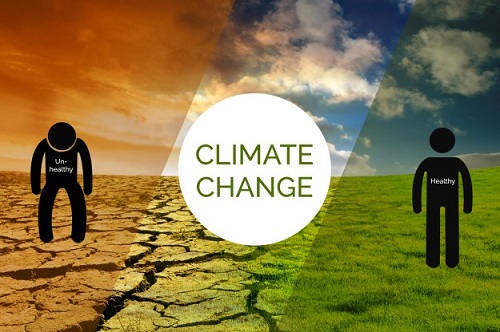
A couple of decades ago, malaria was not a health problem in the highlands of Ethiopia, some studies indicate. But today outbreaks of malaria in the Ethiopian highlands are common. This is because climate change has increased the night-time temperatures in the highlands, allowing malaria-infected mosquitos to live at altitudes where previously they could not survive the cold nights.
This is a clear example for the imminent and direct impact of climate change on public health as longer periods of warm weather have created favorable conditions for mosquitoes to breed and these changes in the highland climate have led to outbreaks of malaria occurring for the first time.
The health impacts of climate change can be direct or indirect. The direct health impacts occur when climate changes in the temperature, precipitation and weather extremes affect our health and survival directly. For example, very hot weather can cause heat-related illness such as heat exhaustion and heat stroke; and floods can cause injury and drowning. These direct effects are predicted to increase as the rate of climate change increases in the future.
The indirect health impacts of climate change are health problems caused by changes in natural and social systems as a result of shifts in the climate, which in turn have adverse effects on human health. Changes to social and ecological systems can allow disease to spread more easily, or cause disease to emerge in areas where previously it was unknown or only present at low levels, studies in the field show.
Climate change has a capacity to increase the frequency of waterborne and food-borne infectious diseases in countries like Ethiopia because of the inadequate supply of safe drinking water, low sanitation coverage and poor hygiene practices. In many of the flood incidents that occurred in many parts of the country there were outbreaks of acute watery diarrhoea among people , according to documents.
Climate change is currently adversely impacting the health and lives of people around the world. This is particularly true in low-income countries. It affects social and environmental determinants of health – clean air, safe drinking water, food security and shelter. There are several mechanisms through which climate change impacts health. However, two main climatic impacts on health are
evident from the literature. The first one is the direct effect caused by heat stress and weather-related extreme events that result in increased morbidity and mortality. The other one is the indirect effect. The indirect effect of climate change is climate-mediated change seen in the incidence of infectious diseases and deaths.
The major health effects include under-nutrition due to variability in agricultural production and food security. Increasing incidence of climate sensitive diseases such as malaria, meningitis, and diarrhea are the other climatic effects. Yet, other adverse health impacts of climate change are caused by scarcity of water and natural disasters such as floods and droughts.
According to the Ethiopian Climate Resilient Green Economy document, the health impacts of climate change will be manifested through morbidity and mortality caused due to extreme temperature. An increase in vector-borne diseases (e.g., malaria and bilharzias) and weather condition-related diseases (e.g., diarrhea and cholera) are also mentioned in the document as other examples of impacts of climate change.
Not only these but also mentioned in the document are health problems due to poor air quality; mortality due to floods and storms, and malnutrition due to shortage of food and water supply. Climate change has played an important role in exacerbating malaria in the eastern African region. This implies that other factors previously suggested to explain the increase in the spread of malaria may be enhancing the impact of climate change. According to the World Health Organization (WHO), 68% of Ethiopians are living in areas at risk of malaria. Changes in climate are also likely to lengthen the transmission period of major vector-borne diseases and alter their geographic range.
Climate change is projected to cause encroachment of malaria from lower altitudes in the Somalia and Afar to higher altitudes in the Tigray and the Amhara regions of Ethiopia. Tanser estimated a 5–7% potential altitudinal increase in malaria distribution. This means that malaria-free highlands in Ethiopia may experience the modest changes to malarial conditions by the 2050s. Conditions for malarial transmission in the highlands of the country are feared to become highly suitable by the 2080s.
The World Health Organization has confirmed that malaria, dengue fever, and yellow fever are the main vector-borne disease concerns of Ethiopia. It was also noted that there is a complicated relationship between climate change and climate-sensitive diseases, given climate variability between regions within Africa over time, and the impacts of the variability at the community-level Transmission of malaria is seasonal and unstable in Ethiopia, with September to December being the peak transmission season. This timing makes the magnitude of the problem higher as these are months of the major crop harvesting season.
This places a significant economic burden on rural households and individuals both through increased out-of-pocket payments and person-days lost. Based on an analysis using malaria morbidity data from the late 1980s until the early 1990s from 50 sites across Ethiopia, malaria epidemics were associated with high minimum temperatures in the preceding months.
Monthly minimum and maximum temperatures and monthly total rainfall, considered as a one-month lagged effect, were significant meteorological factors for transmission of malaria in Jimma. A modeling study from Southern Ethiopia, Falciparum malaria incidence was linked to meteorological data. A positive association was found between malaria incidence and temperature in March, May, and the months between July and October.
A positive association was also found between malaria incidence and rainfall from January to April and in the months of September and November in Southern Ethiopia. A pattern of dramatic decrease and increase in malaria cases before and after the peak rainy season in May was reported in the modeling study mentioned earlier.
In general, the health sector is one of the various sectors that are highly affected by climate change. Therefore, along with other sectors that face challenges from climate change it is important to devise mechanisms of working in collaboration to revamp efforts of curbing climate change.
BY STAFF REPORTER
The Ethiopian Herald June 11/2021




